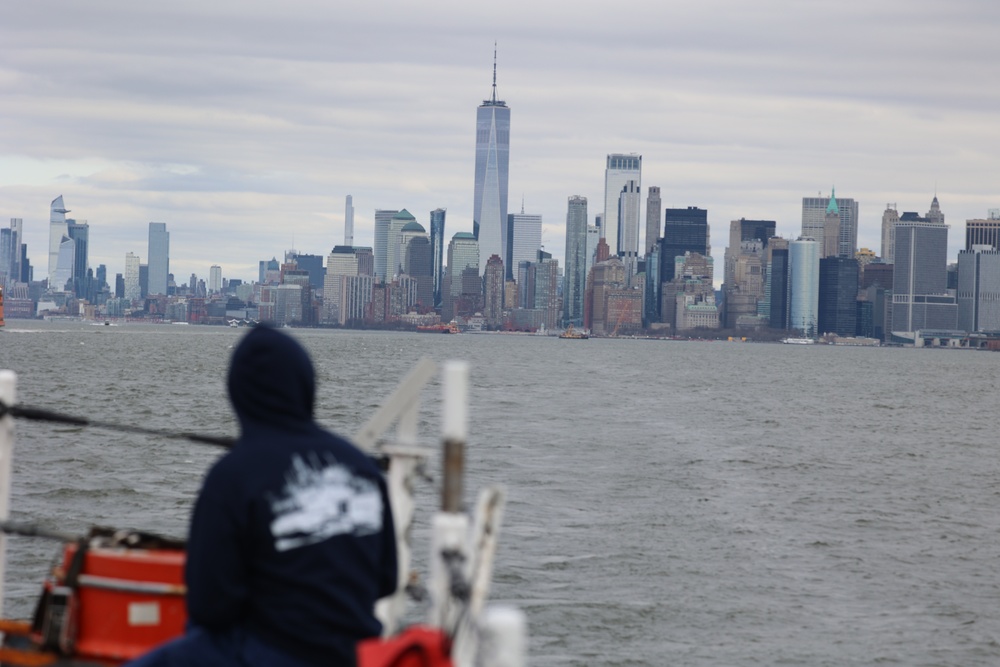NAVAL STATION GUANTANAMO BAY, Cuba – Joint Task Force Southern Guard (JTF-SG) and Naval Station Guantanamo Bay (NSGB) leaders hosted members of the House Armed Services Committee (HASC) Congressional Delegation (CODEL) here, March 7 and 10.
The visits provided an opportunity for lawmakers to observe firsthand the Department of Homeland Security (DHS)-led migrant holding operations and gain a deeper understanding of the repatriation efforts from an interagency and Department of Defense (DoD) perspective.
Both HASC groups received an overall operations brief, focused on how JTF-SG swiftly adapted its maritime mass migration plan to meet the requirements of the DHS-led migrant operations.
“Instead of people trying to go to America, it’s people that are getting removed from America,” said Ryan explaining how the JTF used the skeleton of their maritime mass migration plan and reversed it fit the current mission. “We had the capacity built in eight and a half days. And how do we make that happen? We have all services represented, minus the Space Force. This is a joint operation, so it was a huge team effort.”
Both delegations began their tours at the JTF-SG joint operations center (JOC), where they received comprehensive briefings on base operations and the logistical efforts required to adapt the migration plan so rapidly.
Jesse Williams, the Acting Assistant Director for the Enforcement Division at Immigration and Customs Enforcement (ICE) Enforcement and Removal Operations (ERO), also provided insight into his team’s role in the mission at NSGB.
“We have a large mission set, but we are one of the smallest components in DHS,” Williams noted. “Our holding for ICE is non-punitive. We hold individuals in our custody because we are working on their final removal from the United States,”
The delegations were then guided through an interactive tour of the migrant operations reception center, where they were shown the process illegal aliens undergo upon arrival at NSGB. This included medical screenings and a demonstration of ICE’s capabilities for biometric processing and further screening if required.
Angel Cata, the ICE supervisory detention and deportation officer and key figure in the DHS-led operations explained the significance of the reception center.
“This building was built as part of mass migration and is about 15 years old. The [information technology] infrastructure did exist when it was built, but much else did not,” Cata said. “What you see here has been brought in. We’ve had a lot of effort, a lot of push to get equipment down here, personnel down here.”
Cata also noted the challenges of coordinating operations on an isolated island and the successes of interagency coordination between the Department of Defense (DoD), DHS, and other partner organizations.
“Getting equipment down here is a huge task. Getting our personnel down here – we’ve had a lot of collaborative efforts among the different agencies,” Cata continued. “Within DHS, the Coast Guard helped us out on the onset, very heavily. Whatever they could fly or float, they got it here.”
The CODEL delegation toured the migrant holding areas, where low-threat individuals are housed, as well as the Camp VI detention facility, which houses high-threat illegal aliens. Lawmakers were briefed on the current capacity, security protocols, and contingency plans for potential expansions in response to fluctuating migrant flows.
Through their visits, the CODEL gained an understanding of the critical importance of interagency cooperation in managing the migrant holding facilities, ensuring both national security and adherence to humanitarian standards. The delegates were able to witness firsthand the complex operations and the coordination among DoD, DHS, and other agencies.
Before departing, some of delegates took time to engage with Soldiers, Sailors, Airmen, and Marines from their respective states who were assigned to JTF-SG. The lawmakers expressed their gratitude for the service of these personnel and the service members were able to express how they could support throughout their ongoing efforts.
“Being able to speak directly with lawmakers gave me a sense that our work is valued. It’s reassuring to know they’re actively looking for ways to support us in our mission,” said a Marine assigned to 1st Battalion, 6th Marine Regiment, 2d Marine Division. “They really took the time to listen to our experiences, and having their support means a lot to us. I feel confident knowing they’re advocating for the resources we need.”
| Date Taken: | 03.07.2025 |
| Date Posted: | 03.12.2025 16:56 |
| Story ID: | 492485 |
| Location: | NAVAL STATION GUANTANAMO BAY, CU |
PUBLIC DOMAIN
This work, House Armed Services Committee visits Operation Southern Guard, by SFC ShaTyra Reed-Cox, identified by DVIDS, must comply with the restrictions shown on https://www.dvidshub.net/about/copyright.



 Private Internet Access gives you unparalleled access to thousands
of next-gen servers in over 83 countries and each US state. Your
VPN experience will always be fast, smooth, and reliable.
Private Internet Access gives you unparalleled access to thousands
of next-gen servers in over 83 countries and each US state. Your
VPN experience will always be fast, smooth, and reliable.![DVIDS – Images – Battle Color Training Detachment Visit at MCRD San Diego [Image 11 of 36] DVIDS – Images – Battle Color Training Detachment Visit at MCRD San Diego [Image 11 of 36]](https://101veterans.com/wp-content/uploads/2025/03/1742240612_1000w_q95.jpg)


![DVIDS – Images – Coast Guard conducts joint operation to disrupt illicit maritime activity in Philadelphia [Image 1 of 2] DVIDS – Images – Coast Guard conducts joint operation to disrupt illicit maritime activity in Philadelphia [Image 1 of 2]](https://101veterans.com/wp-content/uploads/2025/03/1742045835_1000w_q95.jpg)


![DVIDS – Images – Advanced Wrath MQ-9 Reaper safety checks, taxi and takeoff [Image 7 of 9] DVIDS – Images – Advanced Wrath MQ-9 Reaper safety checks, taxi and takeoff [Image 7 of 9]](https://101veterans.com/wp-content/uploads/2025/03/1741980963_1000w_q95.jpg)
![DVIDS – Images – U.S. Coast Guard partners with local agencies for MASFO at Port of Seattle [Image 1 of 3] DVIDS – Images – U.S. Coast Guard partners with local agencies for MASFO at Port of Seattle [Image 1 of 3]](https://101veterans.com/wp-content/uploads/2025/03/1741916124_1000w_q95.jpg)

![DVIDS – Images – Battle Color Ceremony for RS San Diego [Image 1 of 7] DVIDS – Images – Battle Color Ceremony for RS San Diego [Image 1 of 7]](https://101veterans.com/wp-content/uploads/2025/03/1741786354_1000w_q95.jpg)
![DVIDS – Images – Air Station Atlantic City helicopter conducts patrol [Image 1 of 3] DVIDS – Images – Air Station Atlantic City helicopter conducts patrol [Image 1 of 3]](https://101veterans.com/wp-content/uploads/2025/03/1741721515_1000w_q95.jpg)